September 20th, 2018
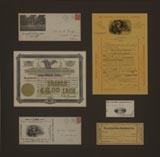 Wow-Alex D. Stanek has located some treasure! The Columbus Zoological Park was located south of Morse/Rathbone Road on the west side of High Street. The east side of High was the “Garden” which was divided into building lots. That neighborhood retains the name “Zooland”. The Zoo was established on land originally owned by John Rathbone. Rathbone died in 1853. That is when the land officially transferred to his daughter Eliza Wetmore and her heirs. Some of these documents feature a tiger. Prior research on the zoo revealed the existence of a meat eater in the animal collection but we’ve always assumed it to be a lion. One photo features a herd of white tail deer. Other animals included rattle snakes, a couple bear cubs, elk, and monkey imported from the Hagenbeck Zoo in Germany. Fabulous finds. [Text courtesy of the Clintonville Historical Society’s Newsletter. Pix courtesy of Alex D. Stranek and the Columbus Metropolitan Library.]
Wow-Alex D. Stanek has located some treasure! The Columbus Zoological Park was located south of Morse/Rathbone Road on the west side of High Street. The east side of High was the “Garden” which was divided into building lots. That neighborhood retains the name “Zooland”. The Zoo was established on land originally owned by John Rathbone. Rathbone died in 1853. That is when the land officially transferred to his daughter Eliza Wetmore and her heirs. Some of these documents feature a tiger. Prior research on the zoo revealed the existence of a meat eater in the animal collection but we’ve always assumed it to be a lion. One photo features a herd of white tail deer. Other animals included rattle snakes, a couple bear cubs, elk, and monkey imported from the Hagenbeck Zoo in Germany. Fabulous finds. [Text courtesy of the Clintonville Historical Society’s Newsletter. Pix courtesy of Alex D. Stranek and the Columbus Metropolitan Library.]
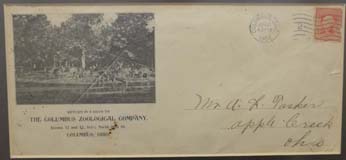
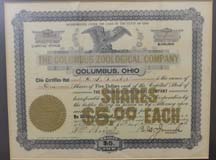
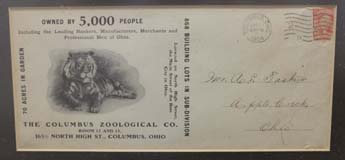
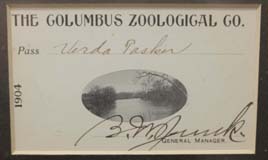

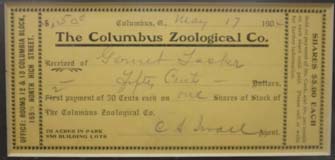
Posted in 1900-1940, Parks & Recreation | 1 Comment »
September 2nd, 2018
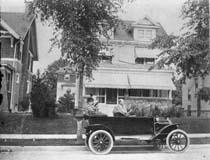 Ron Candage and Rick Lindner kindly identified the car in the photo that I use on my banner. It’s a 1914 Ford touring car.
Ron Candage and Rick Lindner kindly identified the car in the photo that I use on my banner. It’s a 1914 Ford touring car.
From Rick:
The 1912 had no front doors (but did have an option to attach removable ones), the 1913 Ford had brass trim on the side lamps, and the 1915 Ford had curved rear fenders. So this pretty much sets the year at 1914.
From Ron:
Ford made 100s of thousands of these in each of these years and they had factories in other countries which produced right hand drive cars. The car in your picture could have been produced at the Ford Motor Company – Columbus Assembly Plant which was located at 427 Cleveland Ave. This factory started in 1914 and closed in 1939. The components arrived here by train and the automobiles were assembled at the plant for delivery to local dealers.
I’d love to also identify the house in the photo, which seems to be at the address “338 [something].” And check out those beautiful columns in the next-door neighbor’s house!
(I’ve rotated the photo since putting it in the banner.)
[Image by C.C. Hollenback, courtesy of the Dawson family.]
Posted in 1900-1940, Transportation | No Comments »
August 1st, 2018
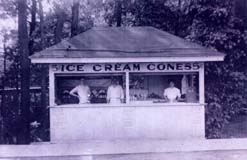 I wonder how many ice cream stands Clintonville has hosted over the years? Surely this one at Olentangy Amusement Park was among the earliest.
I wonder how many ice cream stands Clintonville has hosted over the years? Surely this one at Olentangy Amusement Park was among the earliest.
[Image courtesy of Galen Gonser]
Tags: Olentangy Park
Posted in 1900-1940, Parks & Recreation | No Comments »
July 1st, 2018

In response to John Krygier’s photos of Indianola’s substructure, Alex Campbell sent this lovely photo along.
He says,
There were streetcar tracks on Indianola Avenue from Glen Echo to Oakland Park. The Summit-Steelton standard gauge line was extended north from Glen Echo where the CD&M turned off to head for the private right of way of its Worthington Cutoff. I have conflicting information on just when the Indianola track was built; one date says early 1927 yet it shows up on a 1925 map. It was taken out of service in 1938 when the line was converted to a trolley coach line.
Here is a N. 4th St. photo from 1909 — Fourth Street and 17th Avenue view from southeast corner looking northwest from 17th and west of 4th looking east. Fourth Street north of Chittenden Ave. was the only streetcar line with side of the street right of way in Columbus.
The construction style used to reinforce Indianola (shown in John Krygier’s photos) appear to be similar to tracks used elsewhere in Columbus.
For good measure, Alex also sent along this picture of South 4th St. He says the school building in the left background can still be found on Google maps.

[Photos courtesy of Alex Campbell]
Posted in 1900-1940, Transportation | No Comments »
June 15th, 2018
John Krygier recently sent me the following photos (shown across then down), taken May 2018, with accompanying information:
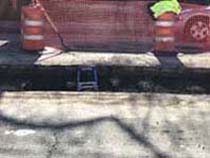
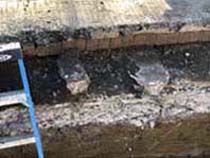
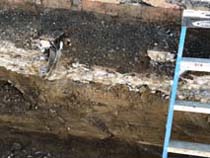
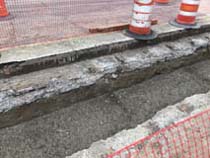
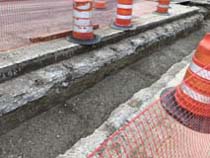
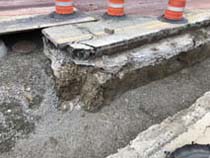
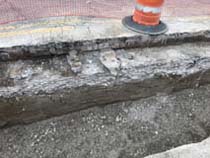
When the City contractor dug down to put the new median (with trees, plants) on Indianola Ave. by Studio35, I took a few photos of the road subsurface and they can be found here.
The construction of the road was rather interesting. Like many other Clintonville streets, Indianola has brick
pavers under the asphalt.
If you look at the photos you will notice that train rails are running perpendicular to the road, and seem to have been used to reinforce the road from below…
I’m wondering if the rails were scrapped from the rail spur that came in from the main line, through Glen Echo (the north side of the ravine) to the old sewer pipe factory (now the site of Columbus International High School).
The cross-section of the roads seems to be (from top down):
Asphalt (newer)
Pavers
Concrete
Soil
Also, here is a PDF about early 20th century street construction in Cleveland, which seems similar to our city streets constructed at the time.
And here is an article about resurfacing roads in Columbus.
Thanks John!
Posted in 1900-1940, 1940-present, Transportation | 2 Comments »
May 24th, 2018
I’ve written in the past about this stunning house at 242 E. N. Broadway–a beautiful renovation job by the current owner. When the house was put on the market in 2018, a video was made and you can tour the house’s interior by video here.
This is the oldest existing house on E.N. Broadway. Here are some old and new pix.
Original house:
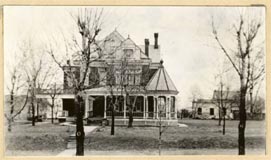
And today, after years of loving restoration:
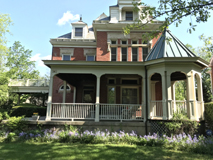
[Video and current image courtesy of Judy Minister Realty. The older image was part of the Clinton League’s notebooks and the digitized equivalent is among the “Ohio History Connection Selections” of the Ohio Memory project. Click on the thumbnail image above to reach their page.]
Posted in 1900-1940, Houses | 1 Comment »
May 1st, 2018
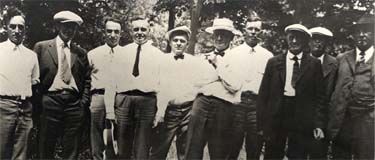
Elford Inc., a commercial construction company located near Grandview on Dublin Road, celebrated its 100th anniversary in 2010.
To mark the occasion, the company published a 70-page hardcover book detailing Elford’s history, from its founding by Edward “Pop” Elford in 1910 to today. It’s available as a PDF here. The book chronicles the company’s history decade by decade, focusing on the marquee projects of each decade.
From a Clintonville and Beechwold perspective, the following are standouts:
Calumet Street Viaduct, 1924.
Beechwold Homes Company, 1941–South of Morse Rd between Indianola and North High Street; 3 streets, 600 homes in just 5 months!
Anderson Concrete Company, 1954–I’m not sure but this could be the concrete plant formerly located on Indianola behind the former Olympic Swimming Pool
Marzetti Manufacturing Plant and Offices, 1984
Wesley Glen Addition, 1995
[PDF booklet courtesy of Elford by way of Wendy Bayer.]
Tags: Beechwold
Posted in 1900-1940, 1940-present, Businesses, Houses, Recent Posts | 2 Comments »
April 10th, 2018
 Amanda Page wrote a very nice article about Frank Packard, architect of the former North High School. The article is in Ravinia Spring/Summer 2014, pp 1,3.
Amanda Page wrote a very nice article about Frank Packard, architect of the former North High School. The article is in Ravinia Spring/Summer 2014, pp 1,3.
Posted in 1900-1940, People, Schools | No Comments »
March 15th, 2018
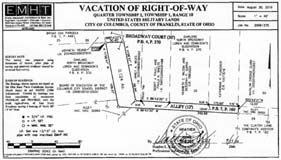 Clintonville Area Com- missioner Judy Minister furnished us with a copy of the deed for Clinton Elementary School. It’s attached as a PDF.
Clintonville Area Com- missioner Judy Minister furnished us with a copy of the deed for Clinton Elementary School. It’s attached as a PDF.
Posted in 1900-1940, Schools | No Comments »
February 15th, 2018
 A nice image of the Calumet Street Viaduct i.e. the Glen Echo / Calumet Street bridge. Elford Company built the bridge around 1924. The photo was taken from the area where the scoreboard on football field of the high school (formerly North High) is located. You can see some houses in the background, which are along Olentangy Street east of Calumet. [Thanks to John Krygier for sending this along to us.]
A nice image of the Calumet Street Viaduct i.e. the Glen Echo / Calumet Street bridge. Elford Company built the bridge around 1924. The photo was taken from the area where the scoreboard on football field of the high school (formerly North High) is located. You can see some houses in the background, which are along Olentangy Street east of Calumet. [Thanks to John Krygier for sending this along to us.]
 And here is the view of those houses today, using September 2016 Google Streetview.
And here is the view of those houses today, using September 2016 Google Streetview.
Posted in 1900-1940, Houses, Transportation | No Comments »
 Wow-Alex D. Stanek has located some treasure! The Columbus Zoological Park was located south of Morse/Rathbone Road on the west side of High Street. The east side of High was the “Garden” which was divided into building lots. That neighborhood retains the name “Zooland”. The Zoo was established on land originally owned by John Rathbone. Rathbone died in 1853. That is when the land officially transferred to his daughter Eliza Wetmore and her heirs. Some of these documents feature a tiger. Prior research on the zoo revealed the existence of a meat eater in the animal collection but we’ve always assumed it to be a lion. One photo features a herd of white tail deer. Other animals included rattle snakes, a couple bear cubs, elk, and monkey imported from the Hagenbeck Zoo in Germany. Fabulous finds. [Text courtesy of the Clintonville Historical Society’s Newsletter. Pix courtesy of Alex D. Stranek and the Columbus Metropolitan Library.]
Wow-Alex D. Stanek has located some treasure! The Columbus Zoological Park was located south of Morse/Rathbone Road on the west side of High Street. The east side of High was the “Garden” which was divided into building lots. That neighborhood retains the name “Zooland”. The Zoo was established on land originally owned by John Rathbone. Rathbone died in 1853. That is when the land officially transferred to his daughter Eliza Wetmore and her heirs. Some of these documents feature a tiger. Prior research on the zoo revealed the existence of a meat eater in the animal collection but we’ve always assumed it to be a lion. One photo features a herd of white tail deer. Other animals included rattle snakes, a couple bear cubs, elk, and monkey imported from the Hagenbeck Zoo in Germany. Fabulous finds. [Text courtesy of the Clintonville Historical Society’s Newsletter. Pix courtesy of Alex D. Stranek and the Columbus Metropolitan Library.]























